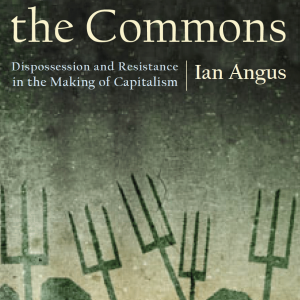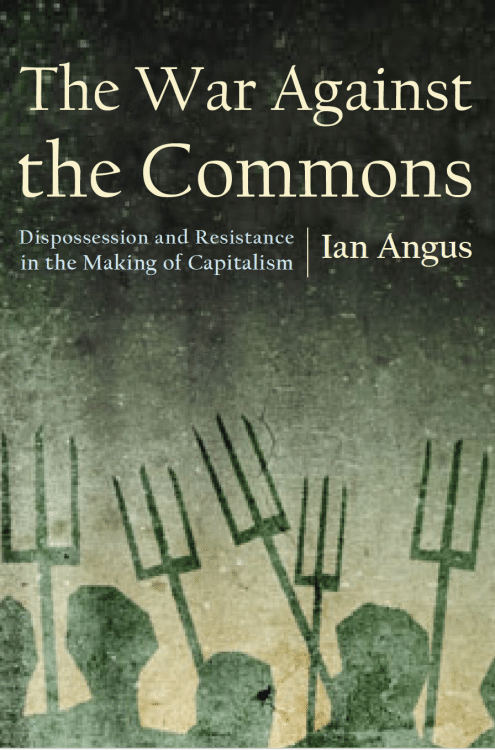The War Against the Commons: Dispossession and Resistance in the Making of Capitalism
by Ian Angus
$26.00 / 246 pages / 978-1-68590-016-8
FOR ALMOST ALL OF HUMAN existence, almost all of us were self-provisioning. Together with our neighbors, we lived and worked on the land, obtained and prepared our own food, and made our own homes, tools and clothing. After our ancestors invented agriculture, most of us lived in small communities where the land was held and farmed in common, and most production was consumed locally.
Today, almost all of us have to work for others.
Our lives depend on, and are largely defined by, our jobs. All the productive wealth is owned by a tiny minority of individuals and corporations, and most of us cannot eat unless we sell them our ability to work.
That’s how capitalism works, and we are so used to it that it seems natural and obvious….
It’s just the way things are: some hard working and clever people have acquired property, and the rest of us are lucky to be able to work for them. It may not be fair, but you can’t change human nature.
…The Tragedy That Wasn’t
If we were to believe an influential article published in Science in 1968, shared, commons-based agriculture ought to have disappeared shortly after it was born. “The Tragedy of the Commons” is one of the most-reprinted articles ever to appear in any scientific journal, and one of the most-quoted: a recent Google search found “about 1,950,000 results” for the phrase “tragedy of the commons.”
The author, Garrett Hardin, a University of California professor who until then was best-known as the author of a biology textbook that argued for “control of breeding” of “genetically defective” people. He had no training in or particular knowledge of social or agricultural history—his real goal was to prove that twentieth-century overpopulation was caused by “the commons in breeding”—but his argument quickly became, in the words of a World Bank Discussion Paper, “the dominant paradigm within which social scientists assess natural resource issues.” It has been used time and again to justify stealing Indigenous peoples’ lands, privatizing health care and other social services, giving corporations “tradable permits” to pollute the air and water, and much more. Anthropologist G. N. Appell says it has been “embraced as a sacred text by scholars and professionals in the practice of designing futures for others and imposing their own economic and environmental rationality on other social systems of which they have incomplete understanding and knowledge.”
Hardin’s argument was a just-so story about the commons in rural England. “Picture a pasture open to all,” he wrote. A herdsmen who wants to maximize his income will calculate that the cost of additional grazing (reduced food for all animals, rapid soil depletion) will be divided among all, but he alone will get the benefit of having more cattle to sell. Inevitably, “the rational herdsman concludes that the only sensible course for him to pursue is to add another animal to his herd. And another; and another.…” But every “rational herdsman” will do the same thing, so the commons will be overstocked and overgrazed until it supports no animals at all. “Freedom in a commons brings ruin to all.”
Key to Hardin’s argument is the unproven assertion that herdsmen always want to expand their herds and cannot be stopped from doing so. “It is to be expected that each herdsman will try to keep as many cattle as possible on the commons.… As a rational being, each herdsman seeks to maximize his gain.” His conclusion was predetermined by his assumptions. “It is to be expected” that each herdsman will try to grow his herd without regard to consequences—and each one does exactly that. It’s a circular argument that proves nothing.
The very fact that commons-based agriculture lasted for centuries disproves Hardin’s assumptions. Where were the gain-maximizing rational herdsmen during all those years, and why did communities fiercely resist all attempts to eliminate common rights?
…Dividing the Land
Getting a private enclosure act passed was only the beginning: the land still had to be divided and allocated, and landlords and capitalist farmers took property very seriously indeed. To ensure that the interests of property were respected, decisions were made by an independent commission, usually three people: one named by the landlord, one by the tithe-owner, and one by other large landholders. Patronage played a big role: commissioners were well paid, and any who hoped to be recommended for future enclosures would be careful to represent their patrons’ interests.
Usually the act specified that a certain proportion of the land would be automatically assigned to the lord of the manor and the tithe-owner, and some land had to be set aside for new roads so farmers could reach their farms without crossing others’ property. After these and other deductions, each proprietor was supposed to receive land equal to the combined value of the land and rights he owned before the act. It would be more than a year, and was often three or four years, before the commissioners’ awards were announced. Only then could the owners begin building roads, erecting fences, planting hedges, and building new farm buildings.
Parliamentary enclosure awards were rarely challenged, which suggests that most commissioners followed the law, but that did not mean the process was fair. In fact, as the Hammonds pointed out, it was never about fairness, it was about property, and the winners were those who already had the most:
Two classes were ignored . . . two classes to whom enclosure meant not a greater or less degree of wealth, but actual ruin. These were such cottagers as enjoyed their rights of common in virtue of renting cottages to which such rights were attached, and those cottagers and squatters who either had no strict legal right, or whose rights were difficult of proof. Neither of these classes was treated even outwardly and formally as having any claim to be consulted.
As well as consolidating land, enclosure eliminated common rights. After the award, “landless commoners could no longer feed pigs, geese and poultry on commons, lanes and roadsides; they could no longer gather fuel; in the fens they lost their fishing and fowling; in forest villages they could no longer hire acommon right for their cattle, unless the commons remained open.”10 In some cases, cottagers received a few acres in exchange for loss of common rights, but because they were charged a disproportionate share of the enclosure costs, including the expensive work of fencing and hedging, many had to sell their rights. And because enclosure acts also terminated existing leases, small tenants often had to abandon farming when landlords doubled or tripled rents.
Two conservative twentieth-century historians called Parlia-mentary enclosure “perfectly proper,” because the law was obeyed and property rights were protected. E. P. Thompson replied that they were ignoring the real issue—“a redefinition of the nature of agrarian property itself.”
In village after village, enclosure destroyed the scratch-as-scratch-can subsistence economy of the poor. The cottager without legal proof of rights was rarely compensated. The cottager who was able to establish his claim was left with a parcel of land inadequate for subsistence and a disproportionate share of the very high enclosure cost.
Enclosure (when all the sophistications are allowed for) was a plain enough case of class robbery, played according to fair rules of property and law laid down by a parliament of property-owners and lawyers. . . .
What was “perfectly proper” in terms of capitalist property-relations involved, none the less, a rupture of the traditional integument of village custom and of right: and the social violence of enclosure consisted precisely in the drastic, total imposition upon the village of capitalist property-definitions….
…A Plain Enough Case of Class Robbery
What’s surprising is not that few commoners submitted counter-petitions, but that some did. The time and difficulty of travelling to London to testify, and the cost of legal assistance, were major barriers to participation, and, as the commoners knew, counter-petitions from the poor rarely succeeded. In most cases they didn’t even try, not because they were too ignorant or frightened, but because Parliament was controlled by the class that was trying to take their land. “Commoners were up against a Parliament of enclosers and they knew it.”14
But that did not mean capitulating without struggle. As Jeanette Neeson has shown, there was substantial local resistance to enclosure acts, primarily in the form of “stubborn non-compliance, foot-dragging and mischief.” Villagers routinely refused to cooperate with surveys, lied about the boundaries of their holdings, and intimidated surveyors. In some cases, the Commission’s surveys and reports were stolen. And when such means failed, some took direct action….
After the defeat of their parliamentary counter-petition the West Haddon commoners, with help from nearby villages, had burned £1,500 worth of posts and rails; when the Wilbarston local counter-petition failed, three hundred men and women tried to prevent the fencing of the common; and when the Raunds parliamentary counter-petition was dismissed petitioners also became rioters: led by the village women and some shoemakers they pulled down fences, dismantled gates, lit huge bonfires and celebrated long into the night.…
The two principal landowners of neighbouring Guilsborough had suffered theft and arson even before their fences had gone up: Richard Clarke’s brakes were burnt, and with them went the gate to his home close, some posts and their rails from his hayrick, and seventy perches of hedging from his fields. Ten days later justice John Bateman lost four gates and their locks. In the following year, opponents of Hardingstone’s enclosure began a systematic campaign of fence-breaking and tree-barking. They kept up their raids for years, destroying live hedges, throwing down posts and rails, digging up sand in the roads.15
When the Earl of Uxbridge fenced 3,500 acres of common land and built warrens for 15,000 rabbits, commoners complained that they had lost grazing land for their sheep, and that the rabbits were destroying their crops. In 1753, after losing their lawsuit on a technicality, some three hundred peasants and laborers invaded the enclosed land and spent two weeks destroying burrows and killing thousands of rabbits. It was a brave act of rebellion, but the earl responded by evicting cottagers and tearing their homes down, and then spent heavily to win a lawsuit against his tenants. A judge in the Court of King’s Bench ruled that a commoner could not “destroy the estate of the lord, in order to preserve his own small right of common.”
…As Marx wrote, Parliamentary Enclosure Acts were “decrees by which the landowners grant themselves the people’s land as private property, decrees of expropriation of the people.”16 Non-compliance, sabotage, and arson inconvenienced the enclosers but couldn’t defeat them. Despite the commoners’ resistance, the wealthy landowners and their state prevailed.
Capitalist modes transmuted offices, rights and perquisites into round monetary sums, which could be bought and sold like any other property. Or, rather, the offices and rights of the great were transmuted in this way—those of the Rangers, bishops, manorial lords. The rights and claims of the poor, if inquired into at all, received more perfunctory compensation, smeared over with condescension and poisoned with charity. Very often they were simply redefined as crimes: poaching, wood-theft, trespass…..


Comments are closed.